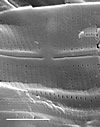Images
Click any image to enlarge...
LM image scalebar = 10 µm = 72 pixels
SEM image scalebar = 1 µm
Observations
| Observations: | |
|---|---|
| Length: | 11-23 µm |
| Width: | 1.6-2.8 µm |
| Striae: | 90-110 in 10 µm |
Description:
Valves linear with rounded to slightly rostrate ends. Valves are extremely lightly silicified. Central sternum is positioned within a thickened linear rib that extends along the apical axis. Raphe is not visible in the light microscope. Striae are not visible in the light microscope. SEM: Externally, valves possess a simple linear raphe. Both proximal and distal raphe terminations are straight. Striae number greater than 90-110 in 10 µm. Striae are composed of simple round to elliptical areolae. Internally, the valves possess a straight termination of the distal raphe. An isolated punctum is present at the raphe termination.
| Morphology: | Naviculoid |
|---|---|
| Distribution: | Antarctic endemic |
Autecology:
Notes:
This taxon does not belong in the genus Navicula Bory, as circumscribed by Cox (1979). The genus that it shares affiliation with is not clear, therefore we leave it within Navicula at the present time. Our specimens have amazingly fine striae at 90-110 striae in 10 µm, a density far finer than that visible in the light microscope. We are not aware of any other diatom with such fine striation, although no other reports of N. lineola var. perlepida include SEM observations. This finely silicified diatom is abundant in Lake Frxyell and Lake Bonney sediments, dominating the total number of cells in core sections indicative of carbonate rich, low lake stand conditions (Whittaker et al., in press). However, this diatom is so fine and difficult to see it may be easily overlooked. Furthermore, the frustules easily adhere to debris and most cell counts are likely underestimates of the abundance. Witkowski (2000) reports this diatom as a marine species common in the Arctic Ocean, yet we see it frequently in inland, but quite saline, lakes. Roberts and McMinn (1999) described Navicula adminii from the Vestfold Hills. Comparison of their pictures with unpublished material from the Vestfold Hills (Van de Vijver, unpublished results) and our material reveals that N. adminii is identical to our N. lineolae var. perlepida under the light microscope. We have not, however, examined the original type material in the SEM and it is possible that the Antarctic specimens should be separated and placed under the name N. adminii. SEM images provided by T. Whittaker and J. Croall.
McMurdo Dry Valleys Waterbodies with Sabbea adminensis
- Aiken Creek
- Blue Lake
- Bowles Creek
- Canada Stream
- Clear Lake
- Green Creek
- Green Lake
- Lake Fryxell
- Lost Seal Stream
- McMurdo Hut Ridge
- Picture Pond
- Pond by Blue Lake
- Pond by Clear Lake
- Pony Lake
- Von Guerard Stream
Original Type Description
| Author: | Van de Vijver, Bishop & Kopalova 2019 |
|---|---|
| Length: | 9-28 µm |
| Width: | 1.9-3.9 µm |
| Striae: | very fine, not discernible in LM |
Original Description:
Valves linear with a low mantle. Girdle composed of several, open copulae, each with a double row of rounded to transapically elongated poroids. Raphe sternum well-developed with the raphe positioned in the middle of the sternum. Raphe straight, simple with straight, non-expanded proximal raphe ends. Terminal raphe fissures absent. Internally, helictoglossae only weakly developed to almost absent. Striae very fine, not discernible in LM, uniseriate, parallel, composed of small, rounded areolae, externally occluded by small hymenes.
New combination
| Author: | (D. Roberts & McMinn) Van de Vijver, Bishop & Kopalova 2019 |
|---|
Citations
Index Nominum Algarum (INA):
- Original
- If an INA link is available, it will be shown above
- The INA is a bibliographic reference "card file" for algal taxonomy, containing nearly 200,000 names of algae (in the broad sense).
Publications (by year):
- Esposito et al. 2008. Botany 86: 1378-1392. [citation 137(134)]
- Bishop et al. 2019 Phytotaxa vol 418, no.1 [citation 178(143)]














